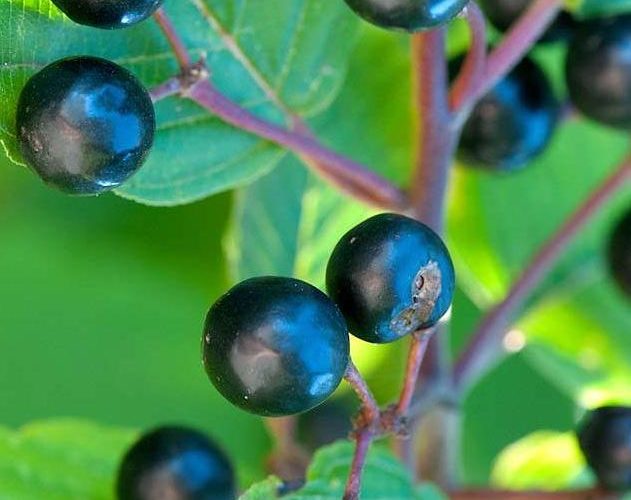Californian buckthorn
(Frangula purshiana purshiana)

Description
Frangula purshiana, commonly known as cascara, is a species of flowering plant belonging to the Rhamnaceae family. This species is native to North America and is widely distributed in the western regions of the United States and Canada, from British Columbia to California. The plant has long been used by Native American tribes for its medicinal properties, and in modern times, it has become an important source of commercial laxatives. Description Frangula purshiana is a deciduous shrub or small tree that can reach up to 10 meters in height, but typically grows to around 5 meters tall. The plant has a straight trunk and a rounded, spreading crown of branches. The bark is dark brown or blackish, with deep longitudinal fissures and thin, scaly ridges. The leaves are simple, alternate, and elliptical to ovate in shape, with serrated margins. The upper surface of the leaf is glossy green, while the underside is paler and hairy. The flowers are small, greenish-white, and arranged in axillary clusters. The fruit is a small, reddish-brown drupe that contains two seeds. Distribution and Habitat Frangula purshiana is widely distributed in the western regions of North America, from British Columbia to California. The plant is typically found in moist, shaded areas, such as streambanks, canyons, and moist forests, at elevations ranging from sea level to 2,000 meters. Cultivation Frangula purshiana can be propagated from seeds or cuttings. The plant prefers moist, well-drained soil and partial shade. It is hardy to USDA zones 6-9. Uses Medicinal The bark of Frangula purshiana has long been used by Native American tribes as a laxative, and it was later adopted by European settlers in North America. The bark contains anthraquinone glycosides, which stimulate the muscular contractions of the intestines and promote bowel movements. These compounds are often referred to as "cascarosides" and are also found in other species of Rhamnaceae, such as Rhamnus cathartica and Rhamnus frangula. In modern times, Frangula purshiana is still used as a laxative and is the primary ingredient in many commercial laxative products. It is also used in the treatment of constipation, hemorrhoids, and irritable bowel syndrome. Other Uses The wood of Frangula purshiana is hard and dense, making it useful for tool handles, fence posts, and other outdoor applications. The bark has also been used as a natural dye for wool and other textiles. Conservation Status Frangula purshiana is not currently considered to be a threatened species. However, the plant is susceptible to habitat destruction and overharvesting for its medicinal bark. In some areas, the plant has been designated as a "species of concern" and is subject to conservation efforts. Conclusion Frangula purshiana is a fascinating and useful plant that has played an important role in the medicinal and cultural history of North America. Its bark has been used for centuries as a natural laxative and is still an important ingredient in many commercial laxative products. The plant is also valued for its hard, dense wood and natural dye properties. As with many plant species, Frangula purshiana faces threats from habitat destruction and overharvesting, and it is important to ensure that this valuable resource is conserved for future generations.
Taxonomic tree:







